Weeping birch. How to grow a dwarf weeping birch
Weeping birch is the right solution for a small garden
Weeping birch is decorative variety ordinary birch. Its beauty lies not only in the white trunk, but also in the openwork crown, in the long thin branches hanging down smoothly.
Weeping birch: structural features
Previously, this species was called warty birch. The homeland of this species of birch is Asia and Europe. The plant is very fond of light, a young weeping birch can even die if it does not have enough of it, while an adult tree becomes ugly. Birch can grow on almost any soil, the tree tolerates drought well.
In young birches, the bark is brownish, and from the age of nine it begins to turn white.
Because of this feature, some young birch trees can be confused with alder. Older trees have deep black cracks at the bottom of the trunk. The color of the branches is brown-red, the branches are covered with small warts, which is why this variety of birch is sometimes called warty. The crown of the tree is branchy, but not too dense.
The shape of the leaves is:
The flowers of the birch are small, collected in earrings-inflorescences at the tips of the branches. The birch tree blooms before the leaves bloom.
A variety of weeping birch
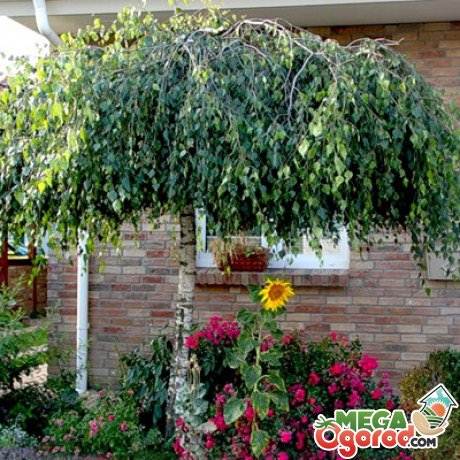
Not everyone can afford a spreading tree, as suburban areas are usually small patches of land. It was for summer residents that agronomists bred a special variety of weeping birch - dwarf weeping birch.
One of these varieties is Jung's variety:
- This tree grows very slowly.
- The branches of this birch descend very beautifully to the ground, and the tree reaches a height of only six meters.
- The plant does not become less beautiful from this, on the contrary, the attractiveness of the variety increases.
- For areas with a small area, these plants are ideal.
- Do not plant a variety next to fruit treessince Jung will inhibit their growth.
Reproduction and planting
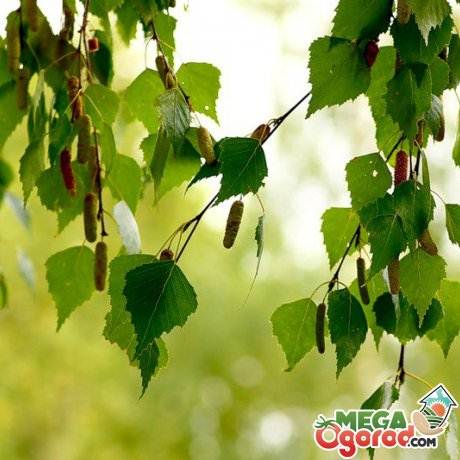
Weeping birch propagates by seed. Sometimes trees are regenerated with shoots. Usually this method is applicable to young trees. Wild conditions don't imply seed reproduction, as this is interfered with by the moss cover. In forests, a weeping birch can only recover with shoots. In just a year, a birch tree can recover from a stump.
Most trees grow from undergrowth, but under favorable conditions, the plant can reproduce by seeds.
Male flowers appear at the tips of the branches. Pollen forms in flowers in spring. Female flowers, similar to earrings, are shorter than male ones. In the eleventh year of life, fruits appear. They look like very small lentils and have two wings. The seeds appear regularly. Some fall in autumn, and some fall in winter, so that when the snow melts, it will be in the ground.
Growing with seeds:
- To grow a weeping birch variety, you first need to collect seeds.
- You need to start collecting late autumnas the earrings begin to turn brown.
- In spring, seeds can be sown in a cool greenhouse.
- Store the seeds in a glass container, but remember that only a third of the seeds will sprout.
- Sprinkle the seeds with earth and lightly crush.
- Place thin branches or straw in place of sowing.
- Water only through such a layer until the first shoots appear.
- Remove branches immediately after sprouting, remove straw carefully, being careful not to damage weak plants.
- Shade the seedlings with a shield.
Tree care and replanting

After the seedlings have grown enough, they must be transplanted to permanent place... It is best to replant the tree before it reaches 7 years old, since after that age it takes root worse.
You need to transplant the plant in March. If the tree has become too large, then it is better to replant it in winter, when the ground is frozen to the roots. This view birch trees may not even grow on fertile soil... It can be planted in any land. Loose humus soil will be a wonderful option. The roots must not be bare.
A lot of water is needed during planting and grooming.
If you use fertilizers, the planting process will be much faster, and the plant will take root better. Dig a hole in the place where you plan to transplant the birch. Mix humus with sand and fill the pit with this mixture. Transplant the tree and top up the soil.
Be sure to water the tree within four days of replanting. An adult weeping birch needs up to 20 liters of water per day on hot days, which is why it is worth growing this tree in fairly humid places.
Grafting weeping birch
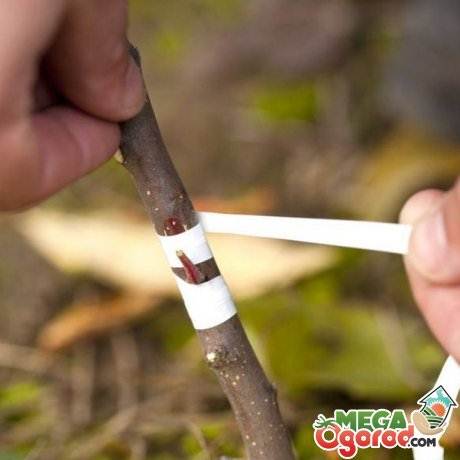
Amazing beautiful plants obtained when grafting branches of a different breed. Decorative weeping birch is no exception. Tree cuttings can be grafted on the most ordinary treeeventually getting beautiful specimen... Such plants are most often found in park areas.
Experienced gardeners give some tips on how to plant a weeping birch:
- The shape of the crown depends only on the place where the cutting is grafted.
- Most often, grafted plants do not reach such a height as ordinary birches, because of this property they are often used in landscape design on small plots of land.
- Such beautiful breeds like Yungi's birch are born precisely by grafting a certain variety of branches onto an ordinary birch. This is how it is created beautiful effect waterfall branches. This technique will help create wonderful forms of birches in the garden.
If the usual white birch, then hanging birch can be made of wood. The tree will be very beautiful, and besides, the used area will be reduced. Thanks to this grafting technology, you can combine willow cuttings and birch bark. Sometimes it is possible to create very bizarre crown shapes.
There are methods by which you can graft a willow on a birch:
- Vaccination work. should be performed while the sap is still moving inside the tree.
- Willow cuttings are in "hibernation" at this time.
- The shoot must be cut off, a willow stalk must be attached to the tree.
- The junction of the escape and the vaccination site must be obliged with a special material, and with the onset of cold weather, it must be insulated.
- The branch will take root by July.
More information can be found in the video.
More information
Description
Hanging birch 'Yoongi' differs in small height and very weeping shape. Small standard tree, picturesque, slow-growing, with an umbrella-shaped, weeping crown, up to 5 m high and up to 3 - 4 m wide, white bark, smooth, there are rare black cracks, flexible shoots. Lives up to 120 years, less often to an older age.
Young trees can be confused with alder, because their bark is brown, and only from 8-10 years old it turns white. In adulthood, it differs well from other trees in the snow-white bark. In older trees, the bark in the lower part of the trunk becomes deeply fractured, black.
The branches are bare, covered with numerous densely friable resinous glands-wart (hence the names of warty birch and weeping birch). Young branches hang down to the ground, which gives the birch crown a very characteristic umbrella-like appearance. The crown is branched, but not dense.
The leaves are light green, smaller than those of the species plant, pointed, triangular, serrate along the edge, bloom in early spring, and in autumn acquire an inimitable yellow color. Leaves from rhombic-ovate to triangular-ovate, smooth, sticky at a young age.
Flowers are yellowish inflorescences - catkins, melliferous, flowering occurs before the leaves open in April - May.
Root system at drooping birch 'Yoongi' surface, can lift road surfaces, sensitive to soil compaction and planting of a near-trunk circle, the presence of drainage, intensively develops.
Loves the sun, very winter-hardy, planting is best done in spring, resistant in industrial conditions.
Any soils, from neutral to slightly acidic, sensitive to salinity, normally develops on alkaline.
Hanging birch 'Yoongi' it is used as a tapeworm, for small gardens and personal plots, decoration of the coastline of reservoirs.
Planting and leaving
Planting features: 'Yungi' drooping birch
They are planted in open areas or in partial shade. Plants with decorative painting leaves when planted in the shade lose their color.
Root collar at ground level.
If the groundwater is close, a drainage layer is poured at the bottom of the planting pit, consisting of rubble or sand 10-20 cm.
Soil mix:
Sod land, peat, sand - 2: 1: 2.
Optimal acidity - pH 6.0 - 7.5
Top dressing:
In early spring before the appearance of leaves and in late spring - early summer, fertilizing with nitrogen-containing fertilizers:
mullein - 1 kg
urea - 10 g
ammonium nitrate - 15-20 g
Autumn dressing mineral fertilizers: nitroammofosk 15-20 g.
The drug is diluted in 10 liters of water. One plant requires 10-20 liters of solution.
Watering:
After planting - 20 liters per plant. Birch has a superficial root system, therefore it requires watering during dry periods at the rate of 10 liters per 1 square meter of crown projection. Young plants require more frequent and abundant watering during dry periods. can intercept moisture from fruit trees, shrubs and garden plants.
Loosening:
Loosening to a depth of no more than 3 cm for weed control.
Mulching:
Mulching the trunk circle with peat, peat compost, wood chips... The thickness of the mulch layer is 8-12 cm.
Cropping:
Cutting dry branches in the spring.
Pest control:
Birch sapwood
Bucephalus crested
Pipe runner beetle
Chafer
Nun's silkworm
Shield
Disease Protection:
Rust
Preparing for winter:
Sprinkle freshly planted young plants trunk circles fallen leaves.
Similar materials
 |
In the garden |
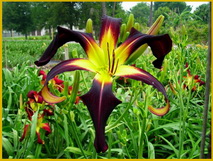 |
Perennial |
Weeping birch is a decorative variety of the common one. Its beauty lies not only in the white trunk, but also in the openwork crown, in the long thin branches hanging down smoothly.
Weeping birch: structural features
Previously, this species was called warty birch. The homeland of this species is Asia and Europe. The plant is very fond of light, a young weeping birch can even die if it does not have enough of it, while an adult tree becomes ugly. Birch can grow on almost any soil, the tree tolerates drought well.
In young birches, the bark is brownish, and from the age of nine it begins to turn white.
Because of this feature, some young birches can be confused with. Older trees have deep black cracks at the bottom of the trunk. The color of the branches is brown-red, the branches are covered with small warts, which is why this variety of birch is sometimes called warty. The crown of the tree is branchy, but not too dense.
The shape of the leaves is:
- Triangular
- Rhombic
- Oval
The flowers of the birch are small, collected in earrings-inflorescences at the tips of the branches. The birch tree blooms before the leaves bloom.
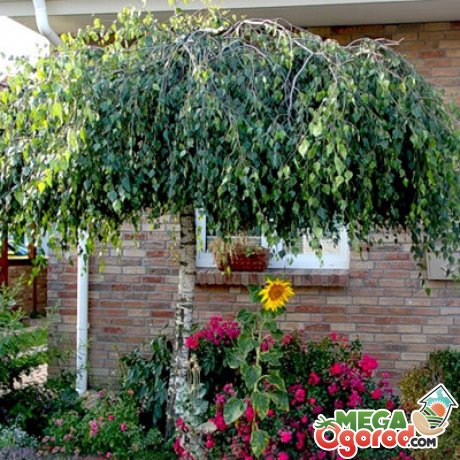
Not everyone can afford a spreading tree, since summer cottages are usually small patches of land. It was for summer residents that agronomists bred a special variety of weeping birch - dwarf weeping birch.
One of these varieties is Jung's variety:
- This tree grows very slowly.
- The branches of this birch descend very beautifully to the ground, and the tree reaches a height of only six meters.
- The plant does not become less beautiful from this, on the contrary, the attractiveness of the variety increases.
- For areas with a small area, these plants are ideal.
- Do not plant the variety next to fruit trees, as Jung will inhibit their growth.
Reproduction and planting

Weeping birch reproduces. Sometimes trees are regenerated with shoots. Usually this method is applicable to young trees. Wild conditions do not presuppose seed reproduction, as moss cover interferes with this. In forests, a weeping birch can only recover with shoots. In just a year, a birch tree can recover from a stump.
Most trees grow from undergrowth, but under favorable conditions, the plant can reproduce by seeds.
Male flowers appear at the tips of the branches. Pollen forms in flowers in spring. Female flowers, similar to earrings, are shorter than male ones. They appear in the eleventh year of life. They look like very small lentils and have two wings. appear regularly. Some fall in autumn, and some fall in winter, so that when the snow melts, it will be in the ground.
Growing with seeds:
- To grow a weeping birch variety, you first need to collect seeds.
- You need to start collecting in late autumn, as the earrings begin to turn brown.
- In the spring, seeds can be sown cool.
- Store the seeds in a glass container, but remember that only a third of the seeds will sprout.
- Sprinkle the seeds with earth and lightly crush.
- Place thin branches or straw in place of sowing.
- Water only through such a layer until the first shoots appear.
- Remove branches immediately after sprouting, remove straw carefully, being careful not to damage weak plants.
- Shade the seedlings with a shield.

There are methods by which you can graft a willow on a birch:
- The work associated with must be performed while the sap is still moving inside the tree.
- Willow cuttings are in "hibernation" at this time.
- The shoot must be cut off, a willow stalk must be attached to the tree.
- The junction of the escape and the vaccination site must be obliged with a special material, and with the onset of cold weather, it must be insulated.
- The branch will take root by July.
More information can be found in the video.
Spread
It grows over a large area in the forest zone of the European part of Russia and in Western Siberia. It is found in a pure composition, sometimes as predominant and often in impurities.
Wood
First-rate tree. By the age of 40-50, under favorable conditions, it reaches 25-30 m in height and up to 80 cm in diameter. Relatively short-lived, lives up to 120 years, less often to a higher age. The bark of young trees is brown, and from 8-10 years old it turns white. In older trees, the bark in the lower part of the trunk becomes deeply fractured, black. The crown is branched, but not dense, the branching is sympodial. Young shoots are naked, with resinous glands - hence the name weeping. Leaves are triangular-rhombic, double-toothed. Weeping birch in free standing begins to bear fruit from 10 years, in a plantation - from 20-25 years. Fruiting continues annually. The fruits ripen towards the end of summer and begin to disperse. In a birch forest, up to 35 kg of birch seeds per hectare can fall annually. The root system of birch is highly developed, but it penetrates the soil shallowly, so the trees are often subjected to windfall. Weeping birch is one of the most light-loving species.
Wood
A sapwood that has the same color of wood throughout the entire section of the trunk. The wood is absent-mindedly vascular, white, with a slight yellowish or reddish tinge. Growth rings are poorly visible at all sections. A narrow, dark strip of dense tissue, which is the late part of the annual layer, runs along the outer border of the annual layers. Early wood is lighter colored. The vessels are small in cross section and evenly scattered. On longitudinal sections, the vessels intersected along the length create a thin streak, characteristic of birch, which is distinguishable only through a magnifying glass. The core beams are narrow and do not differ in color from the general background of the wood. On the end cut, the core rays are hardly distinguishable even with a magnifying glass, and on the tangential cut they are completely invisible. On a regular radial cut, the medullary rays are quite clearly visible in the form of narrow, short shiny lines and dots. Numerous core rays give shine to the longitudinal surfaces of birch wood, and small vessels intersected along them give a slight streakiness. On wood, core repetitions are often found in the form of dots or lines of a reddish-brown color. Vessels of average diameter are relatively few in number, evenly distributed over the entire width of the annual layer, thin-walled, 2–3 closed vessels in the form of small radial chains or single. The outlines of the lumens of single vessels are oval, radially elongated, angular in groups. The density and diameter of the vessels at the inner and outer borders are approximately the same. The segments of the vessels are long, with sharp, short or elongated beaks. Annual layers are relatively narrow. Their border is clearly expressed on the transverse section by a strip of dense tissue, consisting of two or three layers compressed in the radial direction of thin-walled tracheids. The bulk of wood consists of thin-walled or moderately thick-walled fibrous tracheids. Tracheids are located mainly in radial winding rows. The woody parenchyma is scanty, diffuse, and somewhat terminal. The pith rays are very numerous, narrow, one-, two-, three-row; four-row rays are very rare. All rays are much narrower than the diameter of the vessels. When meeting the vessels, the core rays bend. The sinuosity of the pith rays and radial rows of tracheids of birch wood is characteristic. When crossing the boundaries of annual layers, the core rays expand. The annual boundaries of the pith rays and the general boundary of the annual layer coincide. Density at 15% humidity 0.64 g / cm³, at 12% - 0.62 g / cm³, and in an absolutely dry state - 0.49 g / cm³.
Drying
Dries well and relatively quickly. It is characterized as significantly drying out.
Strength
At 12% humidity, the ultimate strength in compression along the fibers is 520 × 10 5 Pa, with static bending - 1 036 × 10 5 Pa; with impact bending - 0.46 × 10 5 Pa. End hardness 389 × 10 5 Pa.
Beautiful deciduous trees or shrubs with a transparent, transparent crown and often with thin, hanging branches and light-colored trunks. In addition to the well-known and widespread in the temperate zone, white birches with long catkins and dense ovoid-rhombic or triangular-ovoid leaves, there are groups of species of a completely different appearance. For example, with rounded ovate fertile catkins directed upwards (woolly birch, Erman birch); with ovoid or oblong-ovate leaves (ribbed birch, Schmidt birch, cherry birch); with bark unusual in color (Daurian birch, ribbed birch, yellow birch, cherry birch, etc.). Almost all species are photophilous, undemanding to the richness of the soil, but they do not tolerate compaction and trampling well. Differ rapid growth, tolerate city conditions well, provided they are planted on a strip of lawn, very frost-resistant.
Warty birch, or drooping - A tree up to 20 m tall, with an openwork, irregular crown and a smooth, white, flaking bark. In mature trees bottom part the trunk is covered with a strong blackish crust, with deep cracks, this is what distinguishes it from most white birch trees. The branches are mostly drooping, young shoots are warty. Leaves are rhombic, glabrous, up to 7 cm, resinous, sticky in youth. The earrings are drooping. The fruit is an oblong-elliptical winged nut.Grows quickly, hardy, undemanding to soil, very light-requiring, drought-resistant. In culture for a very long time. Seed germination is high. The cuttings are poorly rooted.
Hanging birch growth dynamics:Living up to 100-120 years, it continues to grow in height up to 50-60 years, in thickness up to 80 years. During this period, the growth rate changes so in the first 5-6 years, the growth in height is moderate, subsequently increases significantly and, starting from about 10 years, reaches 75-90 cm per year. The final size is about 20 m high. Keep in mind that it also begins to bear fruit around the age of 20, and birch is a pioneer breed. This means that it throws out a great many seeds immediately on the vacated territories (for example, after a forest fire, and in the garden after digging a site), thereby occupying an area and preventing anyone else from germinating. And only then, in the process of competitive struggle, of these seedlings, only a few plants remain, which continue to grow in an area free from other species. In fact, this is not such a problem, as the seedlings are quite easy to pull out.
 In part, the growth of large birches can be limited. Despite the fact that in the domestic literature the possibility of cutting birch is often excluded altogether, it is still possible. Birch trees are often cut in Scandinavian countries. They cut off the top and part of the lateral branches. As a result, the crown thickens, the size of the plant decreases. However, this can only be done with plants that are in the stage of active growth, that is, these are only young plants (trunk diameter up to 15-20 cm). If you cut an old birch in this way, then you will have a bare trunk on the site. But young people also have some problem with pruning. The crown thickens and looks spectacular only in summer, but when the foliage flies around, we see a not very beautiful arrangement of skeletal branches (unnatural). So if this is a dacha, then there is no problem, but if the house is for year-round residence - it makes sense to think well.
In part, the growth of large birches can be limited. Despite the fact that in the domestic literature the possibility of cutting birch is often excluded altogether, it is still possible. Birch trees are often cut in Scandinavian countries. They cut off the top and part of the lateral branches. As a result, the crown thickens, the size of the plant decreases. However, this can only be done with plants that are in the stage of active growth, that is, these are only young plants (trunk diameter up to 15-20 cm). If you cut an old birch in this way, then you will have a bare trunk on the site. But young people also have some problem with pruning. The crown thickens and looks spectacular only in summer, but when the foliage flies around, we see a not very beautiful arrangement of skeletal branches (unnatural). So if this is a dacha, then there is no problem, but if the house is for year-round residence - it makes sense to think well.
Many still remember birch when they talk about roof gardens. Everyone remembers young birch trees growing on the walls of ruined temples and on the roofs of old estates. But we must understand that it is precisely because of its pioneering, which we have already discussed above, that birch sows dilapidated buildings with millions of seeds. Of this million, a very small percentage of seeds penetrate into the cracks, even less into those cracks where moisture gets, some of the remaining ones die, since there is water, but there is no substrate. In the substrate and with water, seedlings begin to develop, but even less of them remain after the first winter, when many die from freezing of the root system. And so year after year. Has anyone seen on the wall or roof mature tree? If you have seen it, then this is the same case for a million, and there is no guarantee that the birch tree you purchased in the garden center, solemnly erected on the roof, will be identical to the one remaining out of a million.
Decorative formswarty birch (drooping) :
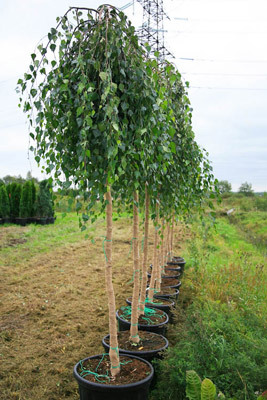 Hanging birch "Yoongi"Betula pendula "Youngii"
- Differs in a tent-like, openwork crown with white bark and shoots drooping to the very ground. The tree is up to 5-9 meters high, with a crown diameter of up to 4-6 meters. The shape of the crown is tent-shaped. The main branches are horizontally directed and curved, forming a picturesque, irregular shape crown with very thin branches drooping to the ground. The bark of the trunk and main branches is white, layered; in old trees, at the base of the trunk, it changes to deeply fissured, black, strong. The leaves are triangular or rhombic-ovate, 3-7 cm long, the edges are double-toothed, glabrous on both sides. Autumn color is yellow. The growth rate is average. Winter hardiness is high, in severe winters freezing of annual shoots is possible. Photophilous. It is unpretentious to soil and moisture, grows equally well both in dry and damp places. Recommended spring planting... Planting in places where trampling and strong soil compaction is possible is not recommended, since birch suffers from soil compaction. It propagates only by grafting on a bole, therefore the total height of the tree depends on the height to which the graft is made. It is used as a tapeworm on the lawn, as an accent in woody and shrub groups and in groups mixed with perennials. Good for framing ponds. Warty birch "Aurea". This slow-growing tree up to 10 m high has very beautiful shiny golden yellow leaves. Their color is especially bright in spring and early summer, and later they turn greenish-yellow. It has no autumn color. Flowers - earrings yellow colorappear in May. Openwork crown with falling branches, white trunk. It grows rather slowly.
Hanging birch "Yoongi"Betula pendula "Youngii"
- Differs in a tent-like, openwork crown with white bark and shoots drooping to the very ground. The tree is up to 5-9 meters high, with a crown diameter of up to 4-6 meters. The shape of the crown is tent-shaped. The main branches are horizontally directed and curved, forming a picturesque, irregular shape crown with very thin branches drooping to the ground. The bark of the trunk and main branches is white, layered; in old trees, at the base of the trunk, it changes to deeply fissured, black, strong. The leaves are triangular or rhombic-ovate, 3-7 cm long, the edges are double-toothed, glabrous on both sides. Autumn color is yellow. The growth rate is average. Winter hardiness is high, in severe winters freezing of annual shoots is possible. Photophilous. It is unpretentious to soil and moisture, grows equally well both in dry and damp places. Recommended spring planting... Planting in places where trampling and strong soil compaction is possible is not recommended, since birch suffers from soil compaction. It propagates only by grafting on a bole, therefore the total height of the tree depends on the height to which the graft is made. It is used as a tapeworm on the lawn, as an accent in woody and shrub groups and in groups mixed with perennials. Good for framing ponds. Warty birch "Aurea". This slow-growing tree up to 10 m high has very beautiful shiny golden yellow leaves. Their color is especially bright in spring and early summer, and later they turn greenish-yellow. It has no autumn color. Flowers - earrings yellow colorappear in May. Openwork crown with falling branches, white trunk. It grows rather slowly.
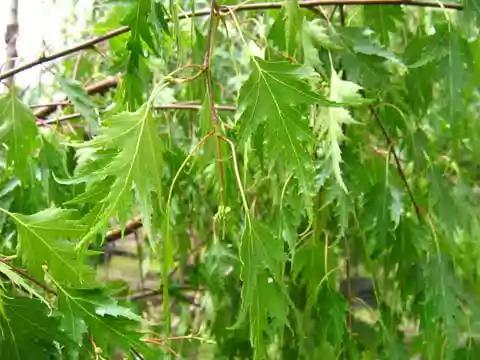 Differs in a weeping crown shape and deeply dissected leaves of light green color.A beautiful tree up to 6-8 meters high with a weeping, transparent crown and a light-colored trunk. Leaves with uneven edges, deeply dissected. In youth, resinous, bright, light green, later - green, in autumn - with an even yellow color. Earrings drooping, long. Growing fast.Winter hardiness is high. Very light-requiring. Drought-resistant. Little demanding on the richness of the soil. Does not tolerate compaction and trampling of the soil.Landing in well-lit areas, preferably in spring time, at autumn planting there is a lot of mortality. Planting in places where a large number of people are possible is not recommended in order to avoid compaction and trampling of the soil.It is used for single and group plantings of the foreground, as well as for the creation of tree-shrub and mixed with perennial groups.
Differs in a weeping crown shape and deeply dissected leaves of light green color.A beautiful tree up to 6-8 meters high with a weeping, transparent crown and a light-colored trunk. Leaves with uneven edges, deeply dissected. In youth, resinous, bright, light green, later - green, in autumn - with an even yellow color. Earrings drooping, long. Growing fast.Winter hardiness is high. Very light-requiring. Drought-resistant. Little demanding on the richness of the soil. Does not tolerate compaction and trampling of the soil.Landing in well-lit areas, preferably in spring time, at autumn planting there is a lot of mortality. Planting in places where a large number of people are possible is not recommended in order to avoid compaction and trampling of the soil.It is used for single and group plantings of the foreground, as well as for the creation of tree-shrub and mixed with perennial groups.
.
Hanging birch "Fastigiata" \u003d Betula pendula "Fastigiata"
Differs in a columnar crown shape.In the winter state, it looks especially attractive due to the fluffy vertical-wavy branches.Slender tree up to 10 -15 meters high.Crohn at a young age is narrow pyramidal. IN mature age wide-columnar, more fluffy, blown out, does not retain its vertical shape. The crown diameter reaches 5 meters wide.The bark of young trunks is white, flakes off in thin layers. Later the bark fades to a dark gray color. In the lower part of the trunk, it becomes roughly fractured and deeply furrowed black. All main branches are strictly vertical and have a branch from the trunk under acute angle... The branches are irregularly wavy-twisted, in adult trees in the upper part of the crown they hang down in an arc-like manner. Young branches are red-brown, partly branched in a bundle-like manner.The leaves are triangular-diamond-shaped, rough, dark green, appearing earlier than those of Betula pendula.Autumn leaf color is yellow, sometimes brown. Fall late.Winter hardiness is high.Photophilous, but tolerates partial shade.It is unpretentious to soil and moisture, but it does not tolerate close bedding groundwater... The root system is superficial.The seaside wind does not tolerate well.Spring planting in a permanent place is preferable, since it does not tolerate transplanting well.Suffers from soil compaction.Formative pruning is possible at a young age.It is used to create group plantings, alleys, tree and shrub groups, field protection belts.
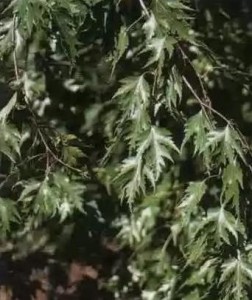 Warty birch "Laciniata" \u003d Hanging birch "Laciniata"
- Differs in a weeping oval crown shape, a white trunk and heavily cut toothed leaves. A tree 10-12 meters high with an elegant, delicate, weeping crown. The shape of the crown is oval. The bark is white, smooth, in the lower part of the trunk, black-gray, fissured. Young trees have brown bark. The leaves are highly indented, with sharp toothed lobes, in summer they are bright green, in autumn they are yellow. Growing fast. Winter hardiness is high; in severe winters, annual shoots can freeze. Very light-requiring. It is not demanding on soil fertility, but it grows better on fresh sandy loam or loamy soils. Does not tolerate the proximity of groundwater. Not very resistant to gas and smoke. Does not tolerate soil compaction. Landing only in lighted areas. If the planting is carried out with seedlings with an open root system, then it is better to carry out it in early spring, since during autumn planting there is a large mortality. It is not recommended to plant in places where soil overconsolidation is possible. Landing near motorways is not recommended. It is used for single and group plantings, the creation of tree and shrub groups in conjunction with species with dense and dark crowns.
Warty birch "Laciniata" \u003d Hanging birch "Laciniata"
- Differs in a weeping oval crown shape, a white trunk and heavily cut toothed leaves. A tree 10-12 meters high with an elegant, delicate, weeping crown. The shape of the crown is oval. The bark is white, smooth, in the lower part of the trunk, black-gray, fissured. Young trees have brown bark. The leaves are highly indented, with sharp toothed lobes, in summer they are bright green, in autumn they are yellow. Growing fast. Winter hardiness is high; in severe winters, annual shoots can freeze. Very light-requiring. It is not demanding on soil fertility, but it grows better on fresh sandy loam or loamy soils. Does not tolerate the proximity of groundwater. Not very resistant to gas and smoke. Does not tolerate soil compaction. Landing only in lighted areas. If the planting is carried out with seedlings with an open root system, then it is better to carry out it in early spring, since during autumn planting there is a large mortality. It is not recommended to plant in places where soil overconsolidation is possible. Landing near motorways is not recommended. It is used for single and group plantings, the creation of tree and shrub groups in conjunction with species with dense and dark crowns.
Location: prefers sunny or slightly shaded places, but there are also fairly shade-tolerant (B. woolly, ribbed, yellow).
Landing: when planting, the distance between plants is not less than 3 - 4 m. The soil mixture consists of leafy earth, peat and sand (2: 1: 2). Drainage from sand with a layer of 15 cm is desirable. Planting is done in early spring at the age of not older than 5-7 years, older ones are planted in winter, with a frozen lump; with autumn planting, there is a large mortality.When planting birches, there is one very important mandatory rule - in no case should the root collar of the seedling be buried. If it is even slightly below the soil level / the tree will suffer for several years, and then it will still die. The fact is that in this case, mycorrhiza completely dies on birch roots, and birches cannot exist without their roommates, mushrooms. For the same reason, birch trees do not tolerate soil filling over the roots of mature trees and an increase in the level of groundwater (the latter is less relevant to the originally boggy species - downy birch, but it is grown relatively rarely). Of course, in the early years, the seedlings should be watered as needed, but later on, not only the majority of "black" birches, but even downy birch, are tolerated with temporary drought.But it is worth thinking about fertilizing the soil, again, only in the case of "black" birches, which are very demanding on this. The best fertilizer will be adding leafy land directly at planting. Well, for white-barked birches, you shouldn't worry about this at all - everything you need will be delivered to these plants by symbiotic mushrooms.
Care: Top dressing. In early spring, before the leaves appear, and at the end of spring, trees are fed: 1 kg of mullein, 10 g of urea, 15 g of ammonium nitrate are taken in a bucket of water. 10 - 20-year-old plants require 30 liters of solution, at 30 and more years - 50 liters.Watering is required during planting and three to four days after it.
Loosening, mulching.
The soil is loosened to a depth of 3 cm while weeding. Trunk circles are mulched with peat, peat compost, wood chips with a layer of 8-12 cm. Cutting, pruning. In the spring, dry branches are cut.
Protection against diseases and pests
... Trumpet beetles damage young shoots and leaves. It is recommended to collect and burn the affected leaves, and dig up the trunk circles. Caterpillars of the nun silkworm and corydalis bucephalus eat the leaves leaving only veins. The caterpillars are shaken off, and the plants are treated with insecticides. May beetles and their larvae eat the roots. It is recommended to dig the soil and select the larvae of Birch fungal diseasestinder fungi, which destroy wood, are especially dangerous. They should be removed. Spraying against rust is carried out by spraying with fungicides, for example, copper oxychloride (0.4%).
Preparing for the winter. Cover the trunks of especially valuable decorative formsplanted in autumn.
Using: are among the best park trees and are highly desirable in gardens and alley plantings, but always on a strip of lawn. Decorative openwork crown, bright color of the bark, light green foliage in spring and golden yellow in autumn. Suitable for all types of planting, especially in combination with mountain ash, willow, oak, linden, maple, beech, bird cherry, as well as with conifers. When planting birches, one should take into account its neighborhood, as a "whip", especially birches with thin hanging branches, from which conifers especially suffer.
Partners: grasses and plants always grow better under a drooping birch than under a fluffy one. In the latter, the crown is denser, the crowns of individual trees are in contact. But there are a number of plants, albeit not many, that could be used underneath. Shade and dryness are the limiting factors here. Among woody plants it would be possible to use common hazel and its varieties, the viburnum and its varieties, assorted snowberries, some spireas (albeit to the detriment of abundant flowering), tree caragana and its varieties, as a ground cover and curling along supports - wood-nose and girlish grapes five-leafed smaller than usual, but white dogwood and its varieties will grow there, some hawthorns and tartar honeysuckle, mahonia holly and chubushniki (although not so abundantly flowering), good bushes, but not very abundantly flowering, will give cinquefoil shrub, good use alpine currants and mountain ash in the range, Chinese junipers, forms and varieties of common spruce, western thuja and other plants. The list of perennials is even larger. The limiting factor is the same - dry shadow. It's good if they are not the most demanding of fertility.
Azalea /// Manchu apricot /// Shrub amorph /// Aralia Manchu /// Black chokeberry /// Japanese scarlet /// Barberry /// Amur velvet /// /// Euonymus European Fortune /// Common privet /// Anagirolist bean /// Hawthorn /// Buddlea /// Elderberry black /// Elderberry /// Elder canadian /// Weigela early /// Weigela blooming /// Gingko two-bladed /// Hydrangea /// Hydrangea paniculata /// Hydrangea gray /// Rough action /// Derain white /// Derain offspring /// English oak /// Red oak /// Tatar honeysuckle /// White willow /// Willow brittle /// Willow red /// Basket willow /// Iva Matsudina /// Purple willow /// Creeping willow /// Irga canadian Kalina Gorodina Viburnum ordinary Caragana tree Catalpa bignoniform /// Horse chestnut /// Japanese keria /// Spread cotoneaster /// Horizontal cotoneaster /// Cotoneaster brilliant /// Maple pseudosibold /// Maple Ginnal /// Sugar maple /// Tatar maple /// Maple silver /// Maple palm-shaped /// Maple red /// Maple false-plane /// Norway maple /// Field maple /// Ash-leaved maple /// Shrub cinquefoil /// Tree hazel /// Common hazel /// Small-leaved linden /// Broad-leaved linden /// Loch narrow-leaved /// Goof silver /// Mahonia holly /// Three-lobed almond /// Sea buckthorn /// Alder gray /// Ailantholus walnut /// Butternut /// Manchurian walnut /// Black walnut /// Holly /// Apical pachisandra /// Bubble plant /// Robinia pseudoacacia /// Dog rose /// Rose gray /// Rose rugosa /// Femoral rose /// Rose wrinkled /// Rose Rugotida /// Rose multiflorous /// Rowan aria /// Mountain ash /// Rowan Turin /// Rowan round-leaved /// Rhododendron /// Broad-leaved rowan /// Hungarian lilac /// Lilac Preston /// Common lilac /// Skumpia leather /// Snowberry white /// Spirea varieties and types /// Stefanandra incised /// Deer-horned sumac /// Poplar pyramidal /// Poplar black /// Average fortification /// Intermediate forsion /// Forsythia ovoid ///


